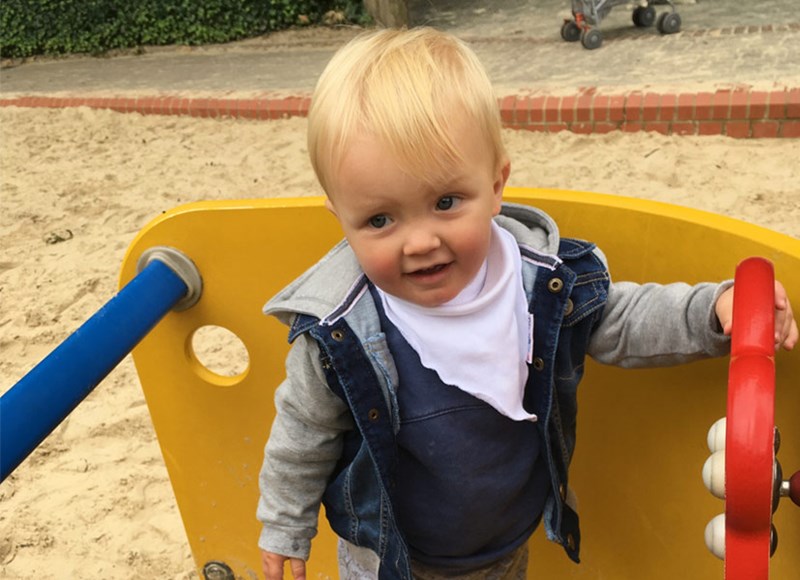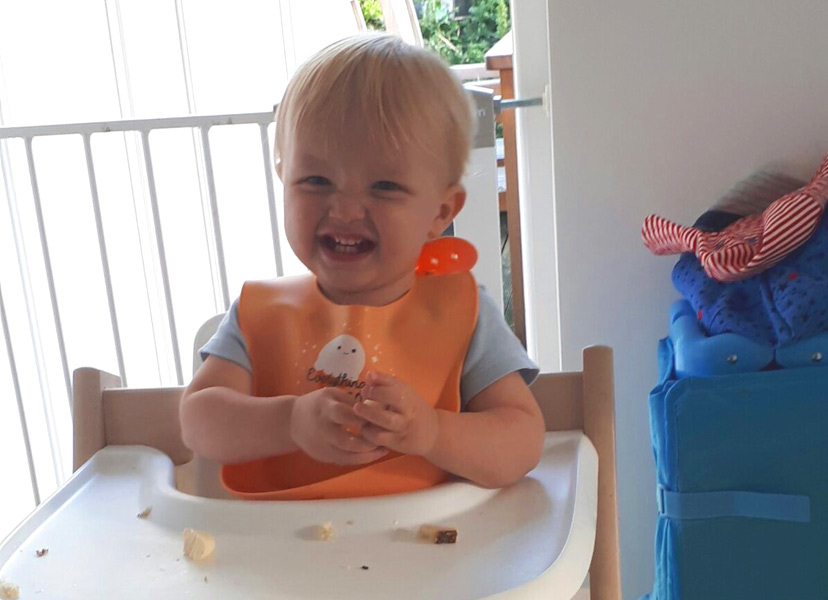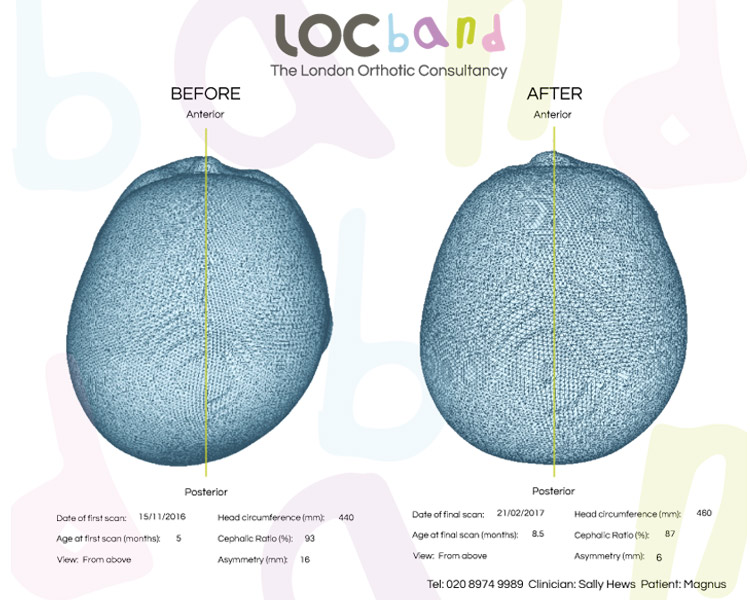
12 March 2018
Earlier this year, mother Maria completed her flat head syndrome journey with her son Magnus who started plagiocephaly treatment in November last year. Flat head syndrome, or positional plagiocephaly, is a condition that causes a baby’s head to become misshapen or flattened and tends to occur when small amounts of pressure over time create a flat spot. Magnus was 5 months old when he started treatment.
“Our son Magnus had developed severe plagiocephaly very early on and by 3 months we had decided that trying the LOCband was our best option” Maria says. The severity of positional plagiocephaly is often determined by an asymmetry score. Clinician Sally Hews says “his asymmetry was 16mm at the beginning, which is considered severe.”
Normally, after a diagnosis of mild plagiocephaly, a GP or clinician will instruct you to try ‘repositioning’ – a technique that requires you to continually move your baby’s head and body position to avoid them resting on the flattened side.
In moderate to severe cases of plagiocephaly, cranial remoulding therapy (we call our version of treatment the LOCband) is proven to be very effective at normalising head shape. The bespoke orthotic helmet is worn for 23 hours a day, is adjusted for growth and results may start to be noticed within the first month. Each bespoke LOCband helmet is made to fit a baby’s individual head shape.

“From the very start everyone at LOC was professional and friendly. Every step of the way was well-explained and measuring and fitting was quick.” Speed can make all the difference for parents who are anxious about their baby’s flat head diagnosis; the cut off age for treatment is around 18 months, because the skull plates move and are no longer malleable.
A consistent concern for lots of parents is that their baby will find the treatment uncomfortable. Fortunately for Maria, like many others who decide to go ahead with treatment, she was surprised by how easily Magnus adjusted to wearing the helmet, “It only took Magnus one day to get used to the band and after that, he wasn’t bothered by it at all. And, most importantly, it worked!”
Significantly, Magnus’s plagiocephaly had reduced from 16mm to 6mm which is within normal range; “we took the band off after 3 months and the difference was amazing. We could have kept it on for longer to get a perfect shape, but decided that 3 months was enough” says Maria. “His head now looks completely normal. I would 100% get a LOCband again if we were to face the same situation again.”
You can see Magnus’s before and after scan results below. If you think your baby might have a flat head or if you are at all concerned about the shape of your baby’s head and would like an immediate opinion from one of our experienced clinicians, take some photographs of your baby from different angles (front, back, both sides and top) and fill in our flat head diagnosis form with your contact details and click submit. One of our plagiocephaly specialists will respond within 24 hours, and if they suspect your baby may have plagiocephaly, you can come in for a free initial consultation, with no obligation to proceed.

This is very much dependent on how fast your baby is growing. The faster the growth, the more frequently your baby will be seen so that the helmet can be adjusted. In general, reviews will happen at two to four-week intervals.
The price of treatment covers:
Yes - All babies that have completed their course of treatment with us have achieved a measurable improvement in head shape. However, you don’t have to take our word for it.
Recent independent research conducted by a University Hospital in Germany has endorsed the treatment for babies with moderate or severe plagiocephaly.
A larger, retrospective study has just been published that found complete correction was achieved in 94.4% of babies treated with helmet therapy.
The results were conclusive: repositioning achieved acceptable correction in 77.1% of cases, but 15.8% were moved onto helmet therapy because re-positioning was not working. Meanwhile, 94.4% of the infants who started in the helmet-treated group achieved full correction, as did 96.1% of those who were transferred from the repositioning group into the helmet-treated group.
Further information can be found on our Plagiocephaly Research page.
If your baby has a temperature or a fever due to illness you must remove the band. The band can be put back on once the temperature has returned to normal.
The optimum age for treatment is between four and seven months.
This is because the skull is most malleable at this age and improvements to head shape tend to take less time and are more dramatic. That is not to say that helmet therapy should be ruled out if the baby is older than seven months. Routinely, babies up to the age of 16 months can be treated very successfully.
The cut off age is around 18 months when the fontanelles (soft spots on the head) are no longer malleable. As babies grow and develop at different rates, it is always worth checking if you are not sure. There have been cases where a baby’s fontanelles have not fused yet by the age of 18 months, who have achieved successful, but less-marked results with cranial remoulding therapy.
Torticollis is a condition in which a tight or shortened muscle in one side of the neck causes the head to tilt or turn to one side, resulting in the infant resting its head in the same position. In 2013, we analysed the data from all first appointments in our Kingston clinic and found that 20% of the babies examined had some kind of neck condition that was causing head immobility.
The clinics and clinicians that provide this treatment in the UK will have received similar training and experience. However, we are the only clinic that manufactures its own helmet and our clinicians are closely involved with the process for each individual helmet that we produce.
In addition, we do not restrict review appointments to a set number, we are extremely flexible and respond to individual parents' needs so that the best outcome can be achieved for each baby.
The LOCband is non-invasive and works by applying gentle, constant pressure over the areas of the baby’s skull that are most prominent while allowing unrestricted growth over the flattened areas. The band consists of a soft foam layer inside a thermoplastic shell. As the baby grows, the band will be adjusted frequently to gently guide the skull into a more symmetrical shape.